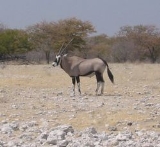
Wildlife of Namibia
Encyclopedia
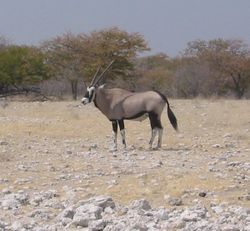
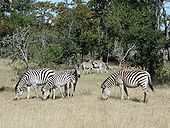

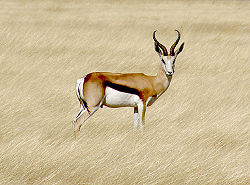
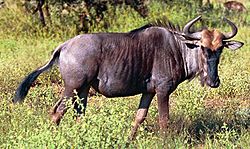
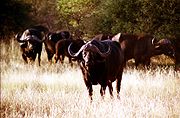

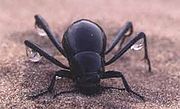
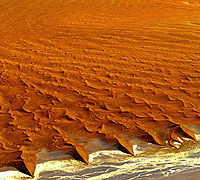
Namibia
Namibia, officially the Republic of Namibia , is a country in southern Africa whose western border is the Atlantic Ocean. It shares land borders with Angola and Zambia to the north, Botswana to the east and South Africa to the south and east. It gained independence from South Africa on 21 March...
is composed of its flora
Flora
Flora is the plant life occurring in a particular region or time, generally the naturally occurring or indigenous—native plant life. The corresponding term for animals is fauna.-Etymology:...
and fauna
Fauna
Fauna or faunæ is all of the animal life of any particular region or time. The corresponding term for plants is flora.Zoologists and paleontologists use fauna to refer to a typical collection of animals found in a specific time or place, e.g. the "Sonoran Desert fauna" or the "Burgess shale fauna"...
.
Namibia's endangered species include Wild Dog
African Wild Dog
Lycaon pictus is a large canid found only in Africa, especially in savannas and lightly wooded areas. It is variously called the African wild dog, African hunting dog, Cape hunting dog, painted dog, painted wolf, painted hunting dog, spotted dog, or ornate wolf...
, Black Rhino, Oribi
Oribi
Oribi are graceful slender-legged, long-necked small antelope found in grassland almost throughout Sub-Saharan Africa.-Description:...
and Puku
Puku
The Puku is an antelope found in wet grasslands in southern Democratic Republic of Congo, in Namibia and in Zambia.Puku stand about 80 centimetres at the shoulder and weigh from 70 to 80 kilograms. Puku are sandy brown in colour, the underbelly is a slightly lighter brown...
. The Puku antelope is limited to about 100 individuals along the Chobe River in Botswana
Botswana
Botswana, officially the Republic of Botswana , is a landlocked country located in Southern Africa. The citizens are referred to as "Batswana" . Formerly the British protectorate of Bechuanaland, Botswana adopted its new name after becoming independent within the Commonwealth on 30 September 1966...
and the Linyati marshes in Namibia. The Black and White Rhino have suffered the most from poaching
Poaching
Poaching is the illegal taking of wild plants or animals contrary to local and international conservation and wildlife management laws. Violations of hunting laws and regulations are normally punishable by law and, collectively, such violations are known as poaching.It may be illegal and in...
and are on the verge of extinction. If there had been no moves to save them in the last 20 years they probably would have disappeared form the wild altogether. Although both species occur naturally in Namibia, today you will find in many of the reserves that they have been reintroduced. The country also has the largest population in southern Africa of cheetah
Cheetah
The cheetah is a large-sized feline inhabiting most of Africa and parts of the Middle East. The cheetah is the only extant member of the genus Acinonyx, most notable for modifications in the species' paws...
not contained within National Parks. There are over twenty species of antelope
Antelope
Antelope is a term referring to many even-toed ungulate species indigenous to various regions in Africa and Eurasia. Antelopes comprise a miscellaneous group within the family Bovidae, encompassing those old-world species that are neither cattle, sheep, buffalo, bison, nor goats...
in Namibia ranging from largest, the Eland
Common Eland
The common eland , also known as the southern eland or eland antelope, is a savannah and plains antelope found in East and Southern Africa. It is the largest antelope in the African continent...
, to smallest, the Damara dik-dik. The Gemsbok
Gemsbok
The gemsbok or gemsbuck is a large antelope in the Oryx genus. It is native to the arid regions of southern Africa, but formerly some authorities included the East African Oryx as a subspecies...
, a striking antelope with long symmetrical horns and distinctive black and white markings is featured on the Namibian coat of arms. Namibia also harbours a wealth of small mammals including Mongoose
Mongoose
Mongoose are a family of 33 living species of small carnivorans from southern Eurasia and mainland Africa. Four additional species from Madagascar in the subfamily Galidiinae, which were previously classified in this family, are also referred to as "mongooses" or "mongoose-like"...
, Jackal
Jackal
Although the word jackal has been historically used to refer to many small- to medium-sized species of the wolf genus of mammals, Canis, today it most properly and commonly refers to three species: the black-backed jackal and the side-striped jackal of sub-Saharan Africa, and the golden jackal of...
as well as the less common Antbear
Aardvark
The aardvark is a medium-sized, burrowing, nocturnal mammal native to Africa...
and Honey Badger, these are not often seen as they are solitary and nocturnal.
National parks and nature reserves
Namibia's parks and reserves range from the open bush of the centre and the north where wildlife is relatively plentiful, to the barren and inhospitable coastal strip with its huge sand dunes. The three main tourist attractions for wildlife in Namibia are Etosha National ParkEtosha National Park
Etosha National Park is a national park in the Kunene Region of northwestern Namibia. The park shares boundaries with the regions of Oshana, Oshikoto and Otjozondjupa....
, Waterberg Plateau National Park and Cape Cross Seal Reserve.
National Parks
- Ai-Ais/Richtersveld Transfrontier ParkAi-Ais/Richtersveld Transfrontier ParkThe ǀAi-ǀAis/Richtersveld Transfrontier Park is a peace park straddling the border between South Africa and Namibia. It was formed in 2003 by combining the Namibian ǀAi-ǀAis Hot Springs Game Park and the South African Richtersveld National Park....
(see also Fish River CanyonFish River CanyonThe Fish River Canyon is located in the south of Namibia. It is the second largest canyon in the world and the largest in Africa, as well as the second most visited tourist attraction in Namibia. It features a gigantic ravine, in total about long, up to 27 km wide and in places almost 550 metres...
and Ai-Ais Hot SpringsAi-Ais Hot SpringsAi-Ais Hot Springs meaning 'burning water' in the local Nama language, refers to the sulphurous thermal hot water springs found in the area. Pronounced "eye-ice", the natural hot-spring oasis is situated at the base of the mountain peaks at the southern end of Fish River Canyon, in the Karas Region...
) - Etosha National ParkEtosha National ParkEtosha National Park is a national park in the Kunene Region of northwestern Namibia. The park shares boundaries with the regions of Oshana, Oshikoto and Otjozondjupa....
- Kaudom National Park
- Mamili National ParkMamili National ParkMamili National Park is a national park in Namibia.Mamili is centered on the Nkasa and Lupala islands on the Kwando and Linyanti rivers in the south-western corner of East Caprivi...
- Mudumu National ParkMudumu National ParkThe Mudumu National Park is a park in Namibia, created in 1990 out of 1009.59 square kilometers of savannah, mopane woodlands, and marsh on the eastern shore of the Cuando River. Many animals can be found in the park including sitatunga, red lechwe, as well as elephants, buffalo, kudu, impala,...
- Namib-Naukluft National Park
- Skeleton Coast Park
- Waterberg National Pak
Nature reserves
- Caprivi Game Reserve
- Kaokoland Nature ReserveKaokoland Nature ReserveThe Kaokoland Nature Reserve is a nature reserve located in northwestern Namibia and is separated from the Atlantic Ocean by the Skeleton Coast Park. Open to visitors throughout the year, the reserve extends over more than 10,000 km² of wide grassy plains and mountain ranges. Visitors must...
- Khaudom Game Reserve
- Mahango Game Reserve
- Mamili Game Reserve
- Mudumugame Game Reserve
Fauna
There are 115 species of fish (5 of them are endemics) in Namibia.There are about 50 species of frogs (6 of them are endemics) in Namibia. There are neither caecilian
Caecilian
The caecilians are an order of amphibians that superficially resemble earthworms or snakes. They mostly live hidden in the ground, making them the least familiar order of amphibians. All extant caecilians and their closest fossil relatives are grouped as the clade Apoda. They are mostly...
s nor salamander
Salamander
Salamander is a common name of approximately 500 species of amphibians. They are typically characterized by a superficially lizard-like appearance, with their slender bodies, short noses, and long tails. All known fossils and extinct species fall under the order Caudata, while sometimes the extant...
s in Namibia.
There are 250 species of reptiles (59 of them are endemics) in Namibia.
There were recorded 1331 species of arachnids (164 of them are endemics) in Namibia. but there is expected to live 5650 species of arachnids in Namibia.
There were recorded 6331 species of insects (1541 of them are endemics) in Namibia, but there is expected to live 35 000 species insects in Namibia. Number of freshwater insects in Namibia include:
- 19 species of Ephemeroptera
- 2 species of PlecopteraPlecopteraPlecoptera are an order of insects, commonly known as stoneflies. There are some 3,500 described species worldwide, with new species still being discovered. Stoneflies are found worldwide, except Antarctica...
- 35 species of TrichopteraTrichopteraThe caddisflies are an order, Trichoptera, of insects with approximately 12,000 described species. Also called sedge-flies or rail-flies, they are small moth-like insects having two pairs of hairy membranous wings...
- 77 species of OdonataOdonataOdonata is an order of insects, encompassing dragonflies and damselflies . The word dragonfly is also sometimes used to refer to all Odonata, but the back-formation odonate is a more correct English name for the group as a whole...
- 179 species of DipteraDipteraDiptera , or true flies, is the order of insects possessing only a single pair of wings on the mesothorax; the metathorax bears a pair of drumstick like structures called the halteres, the remnants of the hind wings. It is a large order, containing an estimated 240,000 species, although under half...
- 1 species of NeuropteraNeuropteraThe insect order Neuroptera, or net-winged insects, includes the lacewings, mantidflies, antlions, and their relatives. The order contains some 6,010 species...
- 200 species of Coleoptera
- 45 species of HemipteraHemipteraHemiptera is an order of insects most often known as the true bugs , comprising around 50,000–80,000 species of cicadas, aphids, planthoppers, leafhoppers, shield bugs, and others...
- 7 species of OrthopteraOrthopteraOrthoptera is an order of insects with paurometabolous or incomplete metamorphosis, including the grasshoppers, crickets and locusts.Many insects in this order produce sound by rubbing their wings against each other or their legs, the wings or legs containing rows of corrugated bumps...
There were recorded the following number of freshwater species in Namibia:
- 3 species of Porifera
- 2 species of CnidariaCnidariaCnidaria is a phylum containing over 9,000 species of animals found exclusively in aquatic and mostly marine environments. Their distinguishing feature is cnidocytes, specialized cells that they use mainly for capturing prey. Their bodies consist of mesoglea, a non-living jelly-like substance,...
- 9 species of Platyhelminthes
- 5 species of Ectoprocta
- 10 species of Nematoda
- 13 species of OligochaetaOligochaetaOligochaeta is a subclass of animals in the biological phylum Annelida, which is made up of many types of aquatic and terrestrial worms, and this includes all of the various earthworms...
- 16 species of Hirudinea
- 52 species of Ostracoda
- 19 species of Copepoda
- BranchiopodaBranchiopodaBranchiopoda is a class of crustaceans. It is the sister group to the remaining crustaceans, and comprises fairy shrimp, clam shrimp, Cladocera, Notostraca and the Devonian Lepidocaris...
: 19 species of Anostraca, 19 species of CladoceraCladoceraCladocera is an order of small crustaceans commonly called water fleas. Around 620 species have been recognised so far, with many more undescribed. They are ubiquitous in inland aquatic habitats, but rare in the oceans. Most are long, with a down-turned head, and a carapace covering the apparently...
, 2 species of NotostracaNotostracaThe order Notostraca comprises the single family Triopsidae, containing the tadpole shrimp or shield shrimp. The two genera, Triops and Lepidurus, are considered living fossils, having not changed significantly in outward form since the Triassic. They have a broad, flat carapace, which conceals the...
and 15 species of ConchostracaConchostracaClam shrimp are a taxon of bivalved branchiopod crustaceans that resemble the unrelated bivalved molluscs. They are extant, and known from the fossil record, from at least the Devonian period and perhaps before... - MalacostracaMalacostracaMalacostraca is the largest of the six classes of crustaceans, containing over 25,000 extant species, divided among 16 orders. Its members display a greater diversity of body forms than any other class of animals, and include crabs, lobsters, shrimp, krill, woodlice, scuds , mantis shrimp and many...
: 6 species of AmphipodaAmphipodaAmphipoda is an order of malacostracan crustaceans with no carapace and generally with laterally compressed bodies. The name amphipoda means "different-footed", and refers to the different forms of appendages, unlike isopods, where all the legs are alike. Of the 7,000 species, 5,500 are classified...
, 4 species of IsopodaIsopodaIsopods are an order of peracarid crustaceans, including familiar animals such as woodlice and pill bugs. The name Isopoda derives from the Greek roots and...
and 6 species of DecapodaDecapodaThe decapods or Decapoda are an order of crustaceans within the class Malacostraca, including many familiar groups, such as crayfish, crabs, lobsters, prawns and shrimp. Most decapods are scavengers. It is estimated that the order contains nearly 15,000 species in around 2,700 genera, with...
Mammals
Animals native to Namibia:There are 200 species of terrestrial mammals (14 of them are endemics) and 40 species of marine mammals in Namibia.
Birds
There are 644 species of birds (14 of them are endemics) in Namibia.Molluscs
There were recorded 26 species of freshwater snailFreshwater snail
A freshwater snail is one kind of freshwater mollusc, the other kind being freshwater clams and mussels, i.e. freshwater bivalves. Specifically a freshwater snail is a gastropod that lives in a watery non-marine habitat. The majority of freshwater gastropods have a shell, with very few exceptions....
s and 13 species of freshwater bivalve
Freshwater bivalve
Freshwater bivalves are one kind of freshwater molluscs. They are bivalves which live in freshwater, as opposed to saltwater. Although the majority of species of bivalve molluscs live in the sea, a number of different families of bivalves live in freshwater...
s in Namibia. There are also number of land gastropods in Namibia.
Flora
There were recorded 4334 species of plants (683 of them are endemics) in Namibia.- Senecio haworthiiSenecio haworthiiSenecio haworthii also known as Woolly senecio is a perennial dwarf shrub of the Senecio genus that grows in South Africa usually between the altitudes of 900 to 1200 meters....
- Woolly senecio - Aloe dichotomaAloe dichotomaAloe dichotoma, also known as Quiver tree or Kokerboom, is a species of aloe indigenous to Southern Africa, specifically in the Northern Cape region, and Namibia....
- Quiver tree

